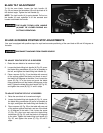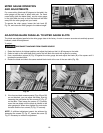
20
Fig. 39A
A
C
B
Fig. 39B
B
(B) can be fastened to the front of the miter gage by
using two wood screws (C) through the holes provided in
the miter gage body and into the wood-facing.
NEVER USE THE FENCE AS A CUT-OFF
GAGE WHEN CROSS-CUTTING.
When cross-cutting a number of pieces to the same length, a
block of wood (B) Fig. 39B can be clamped to the fence and
used as a cut-off gage as shown in Fig. 39B. It is important that
this block of wood always be positioned in front of the saw blade
as shown. Once the cut-off length is determined, secure the
fence and use the miter gage to feed the work into the cut. This
block of wood allows the cut-off piece to move freely along the
table surface without binding between the fence and the saw
blade, thereby lessening the possibility of kickback and injury to
the operator.
WHEN USING THE BLOCK (B) FIG. 39B,
AS A CUT-OFF GAGE, IT IS VERY
IMPORTANT THAT THE REAR END OF THE BLOCK BE
POSITIONED SO THE WORK PIECE IS CLEAR OF THE
BLOCK BEFORE IT CONTACTS THE BLADE.
Ripping is cutting lengthwise through a board. The rip
fence (A) Fig. 40 is used to position and guide the work.
One edge of the work rides against the rip fence while
the flat side of the board rests on the table. Since the
work is pushed along the fence, it must have a straight
edge and make solid contact with the table.
THE SAW BLADE GUARD MUST BE
USED. ON DELTA SAWS, THE GUARD
HAS ANTI-KICKBACK FINGERS TO PREVENT
KICKBACK AND A SPLITTER TO PREVENT THE
WOOD KERF FROM CLOSING AND BINDING THE
BLADE. BE SURE TO REPLACE OR SHARPEN THE
ANTI-KICKBACK DEVICES WHEN THE POINTS
BECOME DULL.
A RIP FENCE SHOULD ALWAYS BE
USED FOR RIPPING OPERATIONS.
NEVER
PERFORM A RIPPING OPERATION FREE-
HAND.
RIPPING
1. Start the motor and advance the work holding it down
and against the fence. Never stand in the line of the
saw cut when ripping. When the rip width is 6 inches
or wider, hold the work with both hands and push it
along the fence and into the saw blade (Fig. 40). The
work should then be fed through the saw blade with
the right hand. Only use the left hand to guide the
workpiece. Do not feed the workpiece with the left
hand. After the work is beyond the saw blade and anti-
kickback fingers, remove hands from the work.
2. When this is done the work will either stay on the
table, tilt up slightly and be caught by the end of the
rear guard, or slide off the table to the floor.
Alternately, the feed can continue to the end of the
table, after which the work is lifted and brought along
the outside edge of the fence. The cut-off stock
remains on the table and is not touched until the saw
blade has stopped, unless it is a large piece allowing
safe removal. When ripping boards longer than three
Fig. 40
A
Fig. 41


















